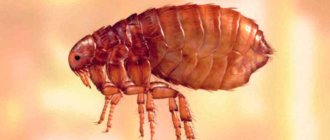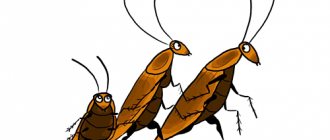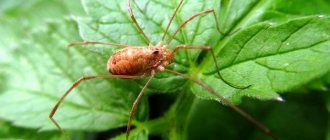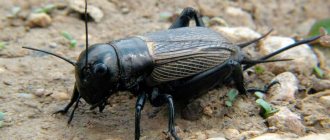How long do insects live? This depends on several factors. When conditions get really bad, some insects go into diapause.
It's a bit of a life on hold until things get better. Fleas take time out if there are no animals nearby to feed on. Typically, insect diapause lasts weeks, months, years.
Which insect lives the longest? The longest-living insects are the Splendor beetles (Buprestidae), some of which remain in the larval stage for more than 30 years.
If there is a fountain of youth for insects, the termite queen drinks from it. She lives to be 50 years old. Apart from these two insects, the cicada lives for 17 years.
Cicada
The female cicada lays her eggs on tree branches. When the nymph hatches from the egg, it falls and buries itself in the ground.
Attaches to the roots of plants and trees. Here it remains motionless for about 17 years, sucking the sap of the roots. After this long “burial”, a mysterious instinct forces the larva to move towards the light. She climbs tree trunks, skin falling apart. A mature cicada emerges.
For about five weeks, the Cicada leads an active life in the sun. After this period he dies. Most species of beetles live only a few days or even hours.
Fire ants
Fire ant queens live from two to six years. The record is seven years. Male fire ants have a much shorter lifespan, ranging from one to six months.
The only function of a male is to mate with an unfertilized reproductive female. After mating he dies.
How many years do insects live?
Animal / Lifespan (average number of years) / Maximum lifespan (long-livers, exception to the rule):
- ants: 5-7 years / 18 years;
- butterflies: from 1 hour to 9 months;
- ticks: 15 years;
- spiders (tarantula): in captivity it lives up to 12 years.
Source: zoo-dom.com.ua
| The very best insects. Lifespan and reproduction |
| Entomology - Insects and humans |
The shortest life |
Bed bugs
An adult bedbug lives from four months to a year under the right conditions. Bed bugs can live for a whole year without feeding and can survive temperatures as low as 50 degrees Celsius. They have adapted to standard insecticides.
Find out more Tick bites: what they look like and what to do if bitten
Bees
The queen bee lives for two to three years. Some species are up to five years old. On average, worker bees live five to six weeks in the summer. During the winter months, a worker can live for up to six months to help maintain the hive, raising new workers for the spring.
A worker bee stings only once. Dies after biting its victim. These bites are to protect the hive or to defend against a threat.
How many years do pets live (cats, rabbits, horses, rats, terrarium inhabitants)
Animal / Lifespan (average number of years) / Maximum lifespan (long-livers, exception to the rule):
- decorative rabbits: 12 years;
- decorative rats: 2-3 years / 6 years;
- Djungarian hamsters: 2.5-3 years;
- pet turtles: 50 years;
- domestic rat: 2-3 years / 6 years;
- hedgehogs: 5-7 years / in captivity up to 16 years;
- snakes (viper): 10-12 years (5 years) / 35 years (25 years);
- dwarf rabbits: 12 years;
- goat: 8-10 years / 15 years;
- cows: 20 years / 35 years;
- castrated cats: 2-3 years longer than non-castrated cats;
- cats: 10-15 years old (34 years old - Ma cat from England and Granpa Rex Alen cat from the USA);
- red-eared turtles: 30-45 years / 50 years;
- rabbits: 12 years;
- rats: 2-3 years / 6 years;
- horses: 20-25 years / 62 years;
- frogs: 7-9 years / 15 years;
- guinea pigs: 6-8 years;
- mice: 1-2 years / 5-6 years;
- Persian cats: 10-15 years;
- gerbils: 5-6 years;
- pigs: 20 years;
- Siamese cats: 10-15 years;
- land turtles: 50 years / 130 years;
- newts: 10-12 years / 27 years;
- already: 20 years old;
- snails: 1-4 years / 8 years;
- hamsters: 1.5-3 years;
- ferrets: 12-13 years;
- turtles: 50 years / 130 years;
- chinchillas: 15 years.
iv>
Cockroaches
Cockroaches live for a couple of years, depending on the species. They can even live up to a week without a head. The lifespan of an adult female German cockroach varies from 20 to 30 weeks.
The average lifespan of adult female American cockroaches is about 440 days.
Top 10: Creepy insects with too long lifespans
As disgusting and scary as it can be to have insects scurrying around your feet late at night, at least they only live a few months before freezing to death when the weather starts to turn cold. Or we just want to think so. In fact, you'll be surprised at how long some of these bugs running around your home live and how much havoc they can wreak in that amount of time.
10. One cockroach lives for a whole year
Initially, one year does not seem so impressive on the scale we are accustomed to. That is until you hear about the amount of damage a cockroach can cause in this one year. Then you will understand why they are considered such a plague for homeowners.
First, let's talk about their mating habits. The average cockroach is ready to mate and give birth to offspring in the third or fourth month of its life. Once they begin to mate, they can give birth to about 400 new individuals during their lifetime. And in three or four months, these children will also be ready to give birth to four hundred children of their own. In two years, you will find yourself face to face with a critical mass of them, provided that all cockroaches survive to adulthood. This is where the next problem begins.
Cockroaches are extremely smart construction managers. They understand what they need to form groups in safe places near food and water, and more importantly they understand resource management. Fifty cockroaches were placed in a tank with three separate colony areas, perfectly equipped to care for them. The catch was that each colony could only contain forty cockroaches. What did they do? They divided into groups of twenty-five individuals and built houses in two colonies, completely ignoring the third. After the colonies were expanded, they all moved into one colony to better manage things.
9. Springtails are a mistake of nature
Springtails aren't the longest living species on this list; in fact, they don't live that long. However, they can easily be called the craziest creatures that we will talk about in this list. First of all, there are probably several of them in your room, right next to you, right now. Don't worry, your house isn't infested with them and you probably never notice them, but you have them. In fact, they are everywhere. You'll even find them in Antarctica, just relaxing as if nothing had happened.
And when we say they live, we don't mean they just survive. They are definitely thriving. With the ability to reduce their body's water content by up to 90 percent, using a chemical called glycerin, they avoid freezing at temperatures that would kill almost all life. And unlike other insects on this list, they don't go into stasis when they encounter such unfavorable conditions. They completely dehydrate themselves and wait for more favorable conditions only in the most undeniably difficult situations.
8. Mayflies live much longer than one day
While adult mayflies actually only live a day in most cases, many others live much longer. In fact, they can live for several years! It's just that during these years spent wingless in the water, they eat everything that can fall into their claws. This is their childhood, during which they are called nymphs. The mayfly typically spends two to three years in this state before suddenly exploding in a cloud of copulation within a few hours of dying. The end of their amazing lives earned them the nickname "24-hour fly," a name that is commonly confused with house flies that actually live for a month or more.
7. A bedbug can live more than a year without feeding.
Good night and sweet dreams, don't let the bugs bite you: this phrase is often used by parents putting their children to bed. Of course, most of these parents aren't actually worried about their children being eaten alive by bed bugs, and probably don't even know that something called a bed bug exists. That is, of course, unless they've been living in New York for the past two years or so. People who lived there during this time probably remember the news that New York was being overrun by countless numbers of these little bloodsuckers, but have you ever wondered how serious their infestation was in the state?
The fact is that this invasion was due to how long these pests can go without food: 18 months. Although insects don't benefit from not feeding for so long, they can still survive and even reproduce without too much trouble, laying up to five eggs a day, and a little less if they're on a bloodless diet. Because these bugs didn't feed, they simply stayed in stores completely undetected for months on end, multiplying and infesting more and more products, making their way into more and more stores. By the time the infestation became apparent, hundreds of clients' homes were already infested with them, and the government's pest control bill had ballooned to an astronomical level. And all because of a pest who snuck into the store a year earlier and simply decided to set up his base there.
6. The hairy bear butterfly caterpillar hibernates for many years.
Most caterpillars are seasonal insects. They are born in the spring, turn into butterflies/moths in the summer, and then die in the fall after the first real frost hits. However, there is one caterpillar that heard about the first cold weather and decided that this situation did not suit it. This caterpillar is the woolly bear caterpillar, and its life is even more incredible than most of the insects on this list.
This particular species of caterpillar can be found throughout the Western Hemisphere, and in most climates it lives a fairly normal lifespan, forecasting the weather for superstitious Canadians. However, there are those who somehow managed to be born in the Arctic. These guys on average only have a week or two to eat their green fat and begin their journey to becoming a butterfly. This is not enough time for the poor creatures, and they usually freeze to death before they can even get close to their goal. The incredible part? They come back to life every year during this two-week window to feed again.
They are not supernatural monsters. Thanks to a chemical circulating through its body, the hairy bear butterfly caterpillar is immune to tissue damage caused by cold weather. She still freezes and is essentially dead for most of the year, but for two weeks she comes back to life. Now let's remember that normal caterpillars take months to become fat enough for their metamorphosis. This means that the hairy bear butterfly caterpillar has to die and freeze in the snow over and over again, and most of them live for fourteen years before they finally turn into a bear butterfly. This is true. There are teenage caterpillars that are even more unpleasant than teenagers of the human race.
5. Cicadas are almost old enough to buy cigarettes.
Cicadas are cool creatures. They are gigantic in size, thousands of them appearing overnight seemingly out of nowhere, leaving only their shed shells as proof of their appearance, and they can scream louder than a car horn blaring right next to your head. In fact, they are so loud that if one of them sang its song right next to you, it would be loud enough to cause permanent hearing loss. These are creatures that look like they came straight out of an old Godzilla movie, with emphasis on the word “old.”
The average cicada spends as much as 17 years buried deep underground, gorging itself and waiting for the day when it can transition from its nymph stage to mate and pass on its genetic code. And then they die immediately after mating, full of happiness, knowing that, seventeen years from now, their children will most likely do the same. If they had just waited just one year, then you might have witnessed cicadas swarming gas stations by the thousands to look cool with a cigarette for all those cicada girls looking for bad boys who live like it's their last day... which is essentially what it is.
4. The queen ant lives long enough to witness the death of all the other ants in her nest.
Everything about an ant queen living in an ant colony is simply amazing. Her life as queen begins with a battle in the air to determine who will be the lucky sperm donor for the entire colony, with her taking an active part in the battle, along with all her suitors. After the male ant successfully mates with her, he shrivels up and dies as if the queen ant is draining the life out of him, succubus-style. This is because it actually is: the male ant's genitals explode into the body after mating, but the sperm taken from that ant will be used for the entire lifespan of the colony. Every ant you see will be a direct descendant of that male and will be born from the sperm stored in the ant's queen during that single mating, and this number can reach several million if the conditions are right.
Why, you ask? This is because the queen ant has an observed lifespan of 28 years. The average life expectancy of her children is usually between three months and a year. This means that she will watch each of her children die, and this process will be repeated for approximately one hundred generations. However, you should not be upset for her, as you would sympathize with an ordinary mother who had to bury several thousand of her children. This system is ideal for her. As long as she bears children, her colony will prosper.
3. Where is the tarantula now that you saw 30 years ago? He's still running around somewhere nearby.
Remember that spider you threw your slipper at in the 80s? He did not forget and did not forgive. We are, of course, now talking about the embodiment of every arachnophobe's worst nightmare - the tarantula. This giant ball of hairy terror can live for a shocking thirty years, and they spend all that time growing larger and larger in size thanks to the way they grow.
Just like snakes, the spider sheds its skin and leaves behind its terrifying shell to let people know that it is lurking nearby, and now larger than the shell you just found. Also, like snakes, the spider will continue to grow in size until it dies. This means that the enormous spider currently lurking in your left earpiece is actually an elderly spider, and has been through worse scares than you can imagine.
The reason we mention this is because tarantulas are true giants, but they weren't originally that way. They had to grow over a very long time. So long, in fact, that the tarantula from Home Alone is likely still alive. There are spiders older than the average person reading this article. Just think about this the next time you are about to kill a spider. There is a possibility that he has lived a better, more fulfilling life than you.
2. Queen termites can live more than 45 years
The queen ant can live for 28 years and give birth to 1,500 babies a day, but she is no comparison to the queen termite. While the average lifespan of a termite queen is only 15 years or so, a queen living in safe conditions can continue to live up to 45 years by simply giving birth to babies continuously, her body expanding to several times its normal size from -for her constant pregnancy. But instead of giving birth to 1,500 larvae a day, she can give birth to up to 30 thousand.
With such numbers, it is clear that the termite queen cannot simply mate once. And this is where the termite king is worth mentioning. From their first meeting in the sky, the king stays with his queen and helps raise his children for the rest of his life, sometimes even living a full 45 years with his queen. It's even romantic if you think about it. Most people who live together for that long end up hating each other.
1. The narrow-bodied green borer can sleep for half a century
A spider that can live for a third of a century and a termite queen teetering just on the edge of half a century? What other surprises has nature prepared? A beetle that can sleep for fifty-one years without any negative effects? Exactly. We will tell you about it further. It is worth noting that this is not the average age of the splendor beetle. They usually only spend a few years burrowed into a piece of wood in their nymph form before they metamorphose into the green borer, however, on many occasions people have observed the green borer being dug out of furniture that was made over fifty years ago.
One such incident occurred in the 1980s, when a beetle emerged from a ladder made in the 1940s. In other words, a beetle older than the Beatles was just hanging out at some lady's house, and it wasn't even the oldest specimen found. Several times the beetle was found alive in furniture made more than fifty years ago! Just think about this the next time you're about to squash a bug. Chances are you've wiped out fifty years of preparation for the big moment when the beetle emerges into sunlight in one fell swoop. Well, who is the monster now?
What is a dog crate? This is usually a rectangular structure with a door and comes in different sizes, which need to be selected depending on the size of the dog. Cages are made from various materials: wire, wood, metal and plastic. If you have a large breed dog, such as a Great Dane or a Serbernard, then you need to buy a large crate for the dog so that it can fully stretch its legs while lying down and not touch the ceiling with its head when sitting. At the same time, a cage that is too large is also not very good, because it does not contribute to the animal’s sense of security. The main purpose of the cage is to confine the animal for safety purposes, protect household property, make travel comfortable, and teach cleanliness.
Fleas
Fleas go through their entire life cycle (eggs, larvae, pupae, adults) in just two weeks or more than a year. Flea larvae remain in their case until they sense vibrations from a nearby food source.
This is why fleas can suddenly appear everywhere. They were waiting for the right moment to enter adulthood. Adult fleas live for about two weeks without a host. Pupae – several months.
flies
Most flies live 15 – 25 days. In fact, flies reach full adult maturity in just 12 days. Once mature, the female lays 150 eggs at a time.
She can lay off six games before she dies. Flies quickly transition from eggs (8 – 20 hours) to the larval stage. Three days to eight weeks to the pupal stage.
Ten days to adulthood. It is interesting to note that temperature affects the rate at which flies mature. The warmer the weather, the faster they will grow and reproduce.
How many years do birds live
Parrots can be considered the longest-livers among birds kept in captivity; they can live for more than six decades; crows and owls can be considered second in this ranking.
They can live up to thirty years. Domesticated small wild birds - orioles, larks, hobbies - live the shortest time in captivity, since the amateur poultry farmer is not able to create adequate conditions for them; they rarely live more than five to ten years.
Animal / Lifespan (average number of years) / Maximum lifespan (long-livers, exception to the rule):
- budgerigars: 12-14 years / 20 years;
- sparrows: 20 years;
- crows: 10 -15 years / 75 years;
- pigeons: 12 years / 50 years;
- geese: 20 years / 80 years;
- woodpeckers: 7-10 years;
- canaries: 10-15 years;
- cockatiels: 15-25 years;
- chickens: 13 years / 20 years;
- swans: 20 years old / 24 years old;
- lovebirds: 12-14 years / 20 years;
- eagle: 25 years;
- Parrots:
- Jaco: 14-16 years old / 49 years old;
- Macaw: 40-45 years old / 64 years old;
- Cockatoo: 30-40 years / 60-70 years;
- gray crane: 12-15 years / 50 years;
- owl: 30 years / 68 years;
- ostriches: 15 years / 40 years.
Mosquitoes
Adult female mosquitoes live more than one month. Males die one to two weeks after they become adults. Female mosquitoes—the ones that bite—rely on blood meals to get nutrients. After bloodletting, eggs are laid.
Find out more How dangerous are gadfly bites?
Sometimes one egg (Aedes mosquitoes), sometimes up to 300 at a time (Culex spp.) - in or near water bodies. The eggs hatch and become larvae or wigglers.
Wigglers enter the puppet stage as quickly as their species and the surrounding weather require. Usually this is several days. The pupa becomes an adult in just two to seven days. Then it hunts for nectar or blood to start the cycle again.
Mosquitoes spend anywhere from four days to one month in water, so it is necessary to rid your property of standing water to control their population.
Ticks
Ticks live three to five months between each stage (egg, larva, nymph, adult). Ticks, which require multiple molts before reaching maturity, can take up to three years to mature.
Once a tick has reached maturity, its sole purpose is to reproduce. The male will die shortly after mating. Some females lay one large batch of eggs before dying.
Others are several smaller batches before the end of their lives comes.
Egg laying lasts from several days to several weeks. Some species complete their life cycle in just 90 days, others in a year. Some take two years to complete their life cycle.
Mayfly flies
Mayflies (Ephemeroptera) live from several hours to several days as adults; some types – only 1 day. Because of this, they are called day flies. They are so short-lived that they don't even have functional mouthparts!
Learn more How to get rid of fruit flies
What's the point when you only live one day. Mayflies appear together in large flocks. They don't have to waste time looking for a mate.
Monarch termite longevity attributed to defense mechanism
Judith Korb noted that monarch termites have the above genes, but they are not activated. The researcher believes that insects have a certain protective mechanism that blocks the aging process. In the near future, the professor plans to introduce jumping DNA into the heads of long-lived termites responsible for sexual reproduction. If, after administration, the insects die prematurely, this will be direct evidence of the existence of a cause-and-effect relationship between longevity and the activity of jumping genes.
Jumping DNA is quite common—humans and animals have it. However, almost no scientific experiments have been carried out in this area; the cause-and-effect relationship between longevity and the activity of these genes has been studied only using the example of Drosophila flies.











